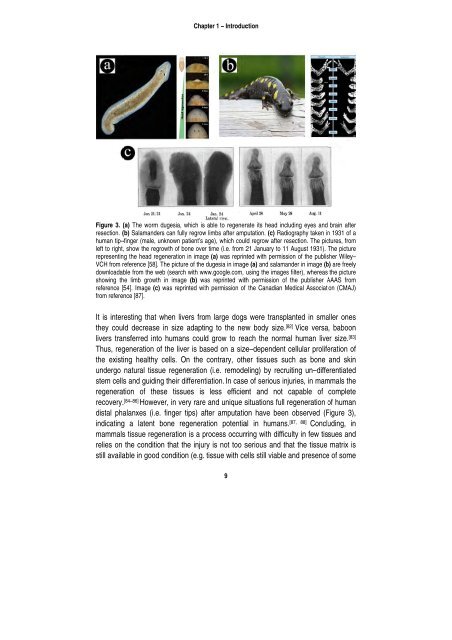Barbieri Thesis - BioMedical Materials program (BMM)
Barbieri Thesis - BioMedical Materials program (BMM)
Barbieri Thesis - BioMedical Materials program (BMM)
Create successful ePaper yourself
Turn your PDF publications into a flip-book with our unique Google optimized e-Paper software.
Chap pter 1 – Introducction<br />
Figure 3. ( (a) The worm duugesia,<br />
which is able to regenerrate<br />
its head including<br />
eyes and brain after<br />
resection. ( (b) Salamanders can fully regrow w limbs after ampputation.<br />
(c) Radiography<br />
taken in n 1931 of a<br />
human tip– –finger (male, unkknown<br />
patient’s age), a which coulld<br />
regrow after re esection. The pic ctures, from<br />
left to right, , show the regrowwth<br />
of bone over r time (i.e. from 221<br />
January to 11 1 August 1931). The picture<br />
representing<br />
the head regeeneration<br />
in imag ge (a) was reprinnted<br />
with permiss sion of the publis sher Wiley–<br />
VCH from rreference<br />
[58]. Thhe<br />
picture of the dugesia in imagee<br />
(a) and salama ander in image (b b) are freely<br />
downloadabble<br />
from the webb<br />
(search with ww ww.google.com, uusing<br />
the images s filter), whereas the picture<br />
showing thhe<br />
limb growth iin<br />
image (b) wa as reprinted withh<br />
permission of f the publisher AAAS A from<br />
reference [554].<br />
Image (c) wwas<br />
reprinted wit th permission of the Canadian Medical M Association<br />
(CMAJ)<br />
from referennce<br />
[87].<br />
It is interresting<br />
that when<br />
livers from<br />
large dogss<br />
were transp<br />
they coulld<br />
decrease in<br />
size adapting<br />
to the neww<br />
body size.<br />
livers trannsferred<br />
into humans could<br />
grow to rea<br />
Thus, reggeneration<br />
of the liver is ba ased on a size<br />
the existiing<br />
healthy ccells.<br />
On the contrary, oth<br />
undergo natural tissuee<br />
regeneration n (i.e. remode<br />
stem cellss<br />
and guiding their different tiation. In case<br />
regenerattion<br />
of thesee<br />
tissues is less efficien<br />
recovery. [84–86] However,<br />
in very rare e and unique s<br />
distal phaalanxes<br />
(i.e. ffinger<br />
tips) af fter amputatio<br />
indicatingg<br />
a latent boone<br />
regenera ation potentia<br />
mammalss<br />
tissue regenneration<br />
is a process p occurr<br />
relies on the condition that the injur ry is not too s<br />
still availaable<br />
in good ccondition<br />
(e.g. tissue with ce<br />
[<br />
lanted in sma<br />
[82] Vice versa<br />
ach the normal<br />
human live<br />
e–dependent cellular prolife<br />
her tissues su uch as bone<br />
eling) by recru uiting un–diffe<br />
e of serious in njuries, in mam<br />
nt and not capable of<br />
situations full regeneration o<br />
on have been n observed (F<br />
al in humans s.<br />
ring with diffic<br />
serious and th<br />
ells still viable<br />
[87, 88] aller ones<br />
, baboon<br />
er size.<br />
Concl<br />
culty in few tis<br />
hat the tissue<br />
and presence<br />
[83]<br />
eration of<br />
and skin<br />
erentiated<br />
mmals the<br />
complete<br />
of human<br />
Figure 3),<br />
uding, in<br />
sues and<br />
matrix is<br />
e of some<br />
9





